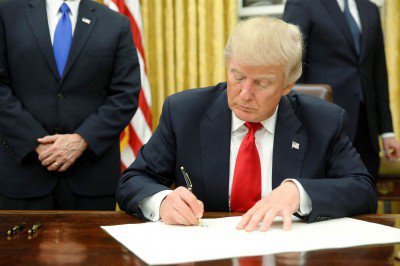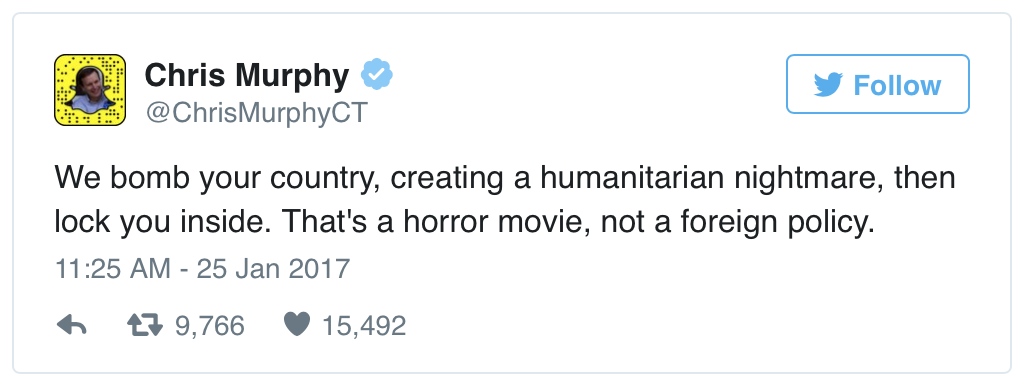Trump’s Muslim Immigration Executive Order: If We Bombed You, We Ban You

An executive order that President Trump is expected to sign shortly restricts visits and immigration from seven Muslim-majority countries: Iraq, Libya, Somalia, Sudan, Syria, Yemen, and Iran.
The draft text of the order was leaked to the Huffington Post and Los Angeles Times. Titled “Protecting the Nation from Terrorist Attacks by Foreign Nationals,” it would suspend the issuance of visas for at least 30 days to most people in the seven countries while the administration revamps its vetting procedures. Most citizens of foreign countries must first obtain a visa before being allowed to enter the United States.
“In order to protect Americans, we must ensure that those admitted to this country do not bear hostile attitudes toward our country and its founding principles,” the draft reads, justifying this blanket prohibition.
The draft relies on Division O, Title II, Section 203 of the 2016 Consolidated Appropriations Act, which lays out security-related exemptions to the visa waiver program, to derive that list of seven countries. In the 2016 law, Iraq and Syria are explicitly listed, Iran and Sudan are included as state sponsors of terrorism, and Libya, Somalia, and Yemen are in the “area of concern” as designated by the Department of Homeland Security.
What all seven countries also have in common is that the United States government has violently intervened in them. The U.S. is currently bombing — or has bombed in the recent past — six of them. The U.S. has not bombed Iran, but has a long history of intervention including a recent cyberattack.
It’s like a twisted version of the you-break-it-you-buy-it Pottery Barn rule: If we bomb a country or help destabilize its society, we will then ban its citizens from being able to seek refuge in the United States.
Connecticut Democratic Sen. Chris Murphy explained this irony in a tweet Wednesday morning:
Here’s a rundown of the countries and the U.S. interventions there:
- IRAN: Iran was the site of a 1953 coup that was assisted by the CIA. The coup brought the Shah Mohammed Reza Pahlavi to power — a dictator who ruled the country until his overthrow in the 1979 Islamic Revolution. Following that revolution, the United States government supported Iraqi leader Saddam Hussein’s war on Iran, even as he used chemical weapons against Iranians. In 1988, the U.S. Navy also mistakenly shot down an Iranian civilian airliner, killing all 290 people on board. More recently, Iran was subjected to one of the world’s first state-sponsored cyberattacks, as the Stuxnet virus was deployed against its nuclear program.
- IRAQ: Four presidents in a row have bombed Iraq. After a decade of brutal sanctions that primarily harmed Iraq’s civil society, rather than its government leadership, the U.S.-led invasion in 2003 has led to hundreds of thousands of deaths, and the resulting destabilization has made Iraq the “world capital of terrorism.”
- LIBYA: From 1986 air strikes to the 2011 military intervention to more recent attacks against ISIS camps in Libya, the country has almost continually been a site of U.S. military actions. Some of the refugees fleeing the country have said they would rather “die at sea” than return to their country.
- SOMALIA: Somalia has been one of the focal points of the drone war, and U.S. support for the Ethiopian invasion of the country did little to help stabilize a territory that is in perpetual humanitarian crisis.
- SUDAN: In 1998, the U.S. blew up the Al-Shifa pharmaceutical plant, which manufactured over half of the country’s pharmaceutical products. Although the attack was supposedly aimed at Osama bin Laden’s terrorist network, no such link ever emerged.
- SYRIA: The U.S. and other countries have been supporting rebel groups in Syria’s civil war for years. The U.S. is also targeting ISIS and other extreme groups in an extensive air-war campaign. Violence on all sides has led to millions of Syrians fleeing the country, fomenting the worst refugee crisis in modern times.
- YEMEN: Yemen is another ground zero for the drone war. The U.S. has also played a functional role in supporting the Saudi-led intervention into the country’s civil war, which has left over 10,000 dead and has millions facing starvation — and led to a resurgence of anti-American terrorist groups that the drone war was supposed to be curtailing.
And consider that Iran, where al Qaeda, ISIS, and other anti-American terrorist organizations have no significant foothold, is included — but Saudi Arabia, where 15 of the 9/11 hijackers came from and which has been a funding source for extremist groups, is not included.


